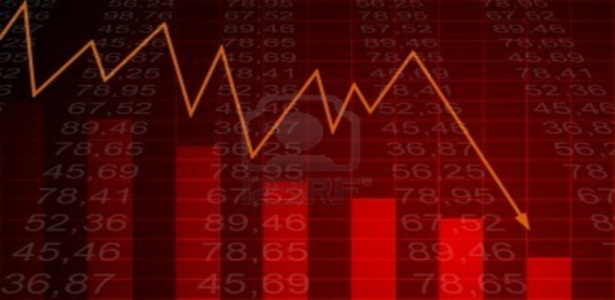There are two pair of single candlestick reversal patterns made up of a small real body, one long shadow and one short or non-existent shadow. Generally, the long shadow should be at least twice the length of the real body, which can be either black or white. The location of the long shadow and preceding price action determine the classification.The first pair, hammer and hanging man, are identical with small bodies and long lower shadows. The second pair, shooting star and inverted hammer, are also identical with small bodies and long upper shadows. Only preceding price action and further confirmation determine the bullish or bearish nature of these candlesticks. The hammer and inverted hammer form after a decline and are bullish reversal patterns, while the
shooting star and hanging man form after an advance and are bearish reversal patterns.The hammer and hanging man look exactly alike, but have different implications based on the preceding price action. Both have small real bodies (black or white), long lower
shadows and short or non-existent upper shadows. As with most single and double
candlestick formations, the hammer and hanging man require confirmation before action.
The hammer is a bullish reversal pattern that forms after a decline. In addition to a potential trend reversal, hammers can mark bottoms or support levels. After a decline, hammers signal a bullish revival. The low of the long lower shadow implies that sellers
drove prices lower during the session. However, the strong finish indicates that buyers regained their footing to end the session on a strong note. While this may seem enough to act on, hammers require further bullish confirmation. The low of the hammer shows
that plenty of sellers remain. Further buying pressure, and preferably on expanding volume, is needed before acting. Such confirmation could come from a gap up or long white candlestick. Hammers are similar to selling climaxes and heavy volume can serve to reinforce the validity of the reversal.The hanging man is a bearish reversal pattern that can also mark a top or resistance level. Forming after an advance, a hanging man signals that selling pressure is starting to increase. The low of the long lower shadow confirms that sellers pushed prices lower during the session. Even though the bulls regained their footing and drove prices higher
by the finish, the appearance of selling pressure raises the yellow flag. As with the hammer, a hanging man requires bearish confirmation before action. Such confirmation can come as a gap down or long black candlestick on heavy volume.
Inverted Hammer and Shooting Star
The inverted hammer and shooting star look exactly alike, but have different implications based on previous price action. Both candlesticks have small real bodies (black or white), long upper shadows and small or non-existent lower shadows. These candlesticks mark potential trend reversals, but require confirmation before action.
The shooting star is a bearish reversal pattern that forms after an advance and in the star position, hence its name. A shooting star can mark a potential trend reversal or resistance level. The candlestick forms when prices gap higher on the open, advance
during the session and close well off their highs. The resulting candlestick has a long upper shadow and small black or white body. After a large advance (the upper shadow), the ability of the bears to force prices down raises the yellow flag. To indicate a
substantial reversal, the upper shadow should relatively long and at least 2 times the length of the body. Bearish confirmation is required after the shooting star and can take the form of a gap down or long black candlestick on heavy volume.
The inverted hammer looks exactly like a shooting star, but forms after a decline or downtrend. Inverted hammers represent a potential trend reversal or support levels. After a decline, the long upper shadow indicates buying pressure during the session.
However, the bulls were not able to sustain this buying pressure and prices closed well off of their highs to create the long upper shadow. Because of this failure, bullish confirmation is required before action. An inverted hammer followed by a gap up or long
white candlestick with heavy volume could act as bullish confirmation.
Blending Candlesticks
Candlestick patterns are made up of one or more candlesticks and these can be blended together to form one candlestick. This blended candlestick captures the essence of the pattern and can be formed using the following:
1.The open of first candlestick
2.The close of the last candlestick
3.The high and low of the pattern
By using the open of the first candlestick, close of the second candlestick and high/low of the pattern, a bullish engulfing or piercing pattern blends into a hammer. The long lower shadow of the hammer signals a potential bullish reversal. As with the hammer,
both the bullish engulfing and piercing pattern require bullish confirmation.
Blending the candlesticks of a bearish engulfing or dark cloud pattern creates a shooting star. The long upper shadow of the shooting star indicates a potential bearish reversal. As with the shooting star, bearish engulfing and dark cloud cover patterns require
bearish confirmation.
More than two candlesticks can be blended using the same guidelines: open from the first, close from the last and high/low of the pattern. Blending three white soldiers creates a long white candlestick and blending three black crows creates a long black candlestick.
Courtesy Copyright Stock Charts.com .This content copyrights protected Written by Arthur Hill.


























































